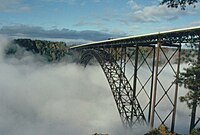American Bridge Company
This article needs additional citations for verification. (December 2014) |
 | |
| Company type | Subsidiary |
|---|---|
| Industry | Civil Engineering |
| Founded | 1900 |
| Headquarters | Coraopolis, Pennsylvania, United States |
Key people | Michael D. Flowers, President and CEO Lanny Frisco, EVP Operations N. Michael (Mike) Cegelis, SVP Marketing and Development |
| Products | bridge building construction marine structures |
| Revenue | |
Number of employees | 500 |
| Parent | Continental Holdings |
| Website | www.americanbridge.net |
The American Bridge Company is a civil engineering firm that specializes in building and renovating bridges and other large civil engineering projects. Founded in 1900, the company is headquartered in Coraopolis, Pennsylvania, a suburb of Pittsburgh. The firm has built many bridges in the U.S. and elsewhere; the Historic American Engineering Record notes at least 81.[1] American Bridge has also built or helped build the Willis Tower, the Empire State Building, the Chrysler Building, launch pads, resorts, and more. During World War II, it produced tank landing ships (LSTs) for the United States Navy. Competitors include Walsh Group, Flatiron Construction, and Skanska USA. Related companies include American Bridge Holding Company and American Bridge Manufacturing Company, both also headquartered in Coraopolis.
History

American Bridge Company was founded in April 1900, when JP Morgan led a consolidation of 28 of the largest U.S. steel fabricators and constructors. The company’s roots extend to the late 1860s, when one of the consolidated firms, Keystone Bridge Company, built the Eads Bridge at St. Louis, the first steel bridge over the Mississippi River and still in use. In 1902, the company became a subsidiary of United States Steel as part of the Steel Trust consolidation.
The company pioneered the use of steel as a construction material; developing the means and methods for fabrication and construction that allowed it to be widely used in buildings, bridges, vessels, and other plate applications.[citation needed] It went on to do work across the nation and around the world.
During World War II, the company built warships for the U.S. Navy. In 1944, American painter Thomas Hart Benton recorded the construction and launch of LST 768, producing numerous drawings and a painting, Cut the Line.[2]
The company went private in 1987 and was sold to Continental Engineering Corporation in 1988.[3]
The town of Ambridge, Pennsylvania, was an American Bridge company town (thus the name "Ambridge"), and is near their current headquarters of Coraopolis, Pennsylvania. Both municipalities are on the Ohio River near Pittsburgh, with access to many steel suppliers, as well as to waterborne and rail transport, to allow shipment of components and subassemblies.
Notable projects

This is a representative, not an exhaustive, list.
Bridges
- Hercilio Luz Bridge, Florianópolis, Brazil (1926)
- Silver Bridge, Point Pleasant, West Virginia (1927)
- San Francisco–Oakland Bay Bridge, Oakland, California (1936)
- Mackinac Bridge, Mackinac Straits, Michigan (1957)
- Verrazano-Narrows Bridge, New York Harbor (1964)
- Macarthur Causeway, Miami, Florida (1997)
- Built the longest concrete segmental cable stay bridge in the United States
- Sunshine Skyway Bridge, Tampa Bay, Florida (1986)
- Built the longest suspension bridge in South America, and one of the longest in Europe.
- Orinoco Bridge, Venezuela (1967)
- 25th of April Bridge, Lisbon, Portugal (1966)

- Built the world's longest arch bridge on three occasions.
- New River Gorge Bridge, West Virginia, 1977, 518 meters, (1,700’)
- Bayonne Bridge, Staten Island-New Jersey, 1932, 504 meters (1,652’)
- Hell Gate Bridge, New York City, 1916, 298 meters (978’)
- Built the world’s longest self-supporting continuous truss bridge.
- Astoria Bridge, Oregon, 1966, 376 meters (1,232’)
- Renovations of existing bridges
- Moved an existing Norfolk Southern vertical lift bridge from Florence, Alabama, to Hannibal, Missouri, (1995)
- First aerial spinning for additional main cables on a loaded, fully operational suspension bridge. 25 April Bridge in Lisbon, Portugal (1998)
- First stiffening truss replacement on a loaded, fully operational suspension bridge. Lions Gate Bridge, Vancouver, British Columbia, Canada (2001)
- The ongoing Eastern span replacement of the San Francisco–Oakland Bay Bridge, in a joint venture with Fluor Corporation, American Bridge-Fluor.
Buildings

- Built the world’s tallest building on numerous occasions.
- Willis Tower, Chicago, 1974, 443 meters (1,454’)
- Empire State Building, New York City, 1932, 381 meters (1,250’)
- Chrysler Building, New York City, 1931, 319 meters (1,046’)
- Woolworth Building, New York City, 1913, 241 meters (792’)
- Built many other well-known buildings.
- John Hancock Center, Chicago (and in Boston)
- Aon Center (formerly Standard Oil), Chicago
- Columbia Seafirst Center, Seattle
- U.S. Steel Tower, 1970
- Flatiron Building, New York City, 1902
- Built the world’s largest building by volume twice.
- Vehicle Assembly Building, Kennedy Space Center, 1964
- Boeing 747 Assembly Building, Everett, Washington, 1974
- Built two of the most notable domed stadium structures in the world
- Louisiana Superdome, 1974
- Houston Astrodome, 1964
Miscellaneous
- Space launch complex jacking for McDonnell Douglas Astronautics (now Boeing) (1994)
- Built bottom framework for the unique, modular room units for Walt Disney Company at the Contemporary Resort in Walt Disney World (1971).
See also
Notes
- ^ Historic American Engineering Record. The firm listed as the builder of a project is usually not the designer. In most cases, the bridge designer or building architect does not select the construction company, which is chosen by the owners/developers. The designer and the contractor work together closely to get the job done.
- ^ Sebak, Rick (November 2009). "A Portrait of the Artist Thomas Hart Benton in Ambridge During World War II". Pittsburgh Magazine. Retrieved January 5, 2015.
- ^ Gaynor, Pamela (2000-07-23). "Something old is new again for American Bridge". Pittsburgh Post-Gazette. Retrieved 2014-12-02.
External links
Company information
Projects and history
- HAER record of at least 81 ABC bridges/projects
- American Bridge Company Chronological history from the company site
- Old Economy Village history page with American Bridge Company history.
- News article on American Bridge legacy
- Another article on legacy.
